Galls or cecidia are a kind of swelling growth on the external tissues of plants. Plant galls are abnormal outgrowths of plant tissues, similar to benign tumors or warts in animals. They can be caused by various parasites, from viruses, fungi and bacteria, to other plants, insects and mites. Plant galls are often highly organized structures so that the cause of the gall can often be determined without the actual agent being identified. This applies particularly to insect and mite plant galls. The study of plant galls is known as cecidology.

Diplolepis is a genus of approximately fifty species of gall-inducing wasps in the family Diplolepididae. The larvae induce galls on wild roses (Rosa), and rarely on domestic roses.
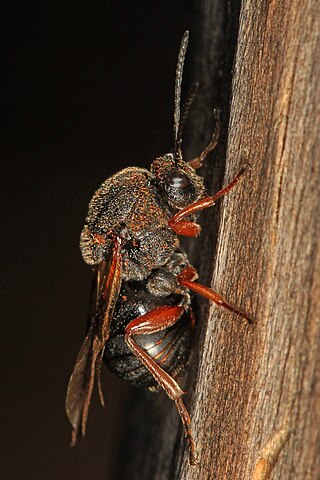
Gall wasps, also traditionally calledgallflies, are hymenopterans of the family Cynipidae in the wasp superfamily Cynipoidea. Their common name comes from the galls they induce on plants for larval development. About 1,300 species of this generally very small creature are known worldwide, with about 360 species of 36 different genera in Europe and some 800 species in North America.

Frangula californica is a species of flowering plant in the buckthorn family native to western North America. It produces edible fruits and seeds. It is commonly known as California coffeeberry and California buckthorn.

Diplolepis rosae is a gall wasp which causes a gall known as the rose bedeguar gall, bedeguar gall wasp, Robin's pincushion, mossy rose gall, or simply moss gall. The gall develops as a chemically induced distortion of an unopened leaf axillary or terminal bud, mostly on field rose or dog rose shrubs. The female wasp lays up to 60 eggs within each leaf bud using her ovipositor. The grubs develop within the gall, and the wasps emerge in spring; the wasp is parthenogenetic with fewer than one percent being males.

Andricus quercuscalifornicus, or the California gall wasp, is a small wasp species that induces oak apple galls on white oaks, primarily the valley oak but also other species such as Quercus berberidifolia. The California gall wasp is considered an ecosystem engineer, capable of manipulating the growth of galls for their own development. It is found from Washington, Oregon, and California to northern regions of Mexico. Often multiple wasps in different life stages occupy the same gall. The induced galls help establish complex insect communities, promoting the diversification in niche differentiation. Furthermore, the adaptive value of these galls could be attributed their ecological benefits such as nutrition, provision of microenvironment, and enemy avoidance.

Diplolepis polita, known generally as the spiny leaf gall wasp, is a species of gall wasp in the family Cynipidae. It was first described by William Harris Ashmead in 1890.

Diplolepis ignota is a species of gall wasp (Cynipidae). Galls in which the larvae live and feed are formed on the leaves of several species of wild rose (Rosa). Individual galls are single-chambered and spherical, but multiple galls can coalesce into irregularly rounded galls.

Feron parmula, also known as the disc gall wasp, is a species of oak gall wasp in the genus Feron. It induces galls in a wide selection of oak species, especially white oaks, and including hybrids. The galls are disc-shaped, up to 3 mm in diameter, and pale with red streaking. Adult females emerge in April. The galls induced by F. parmula superficially resemble the galls of Feron gigas,Andricus viscidus, and newly identified species called the "plate gall wasp" and the "orange-cap gall wasp" by Ronald Russo. Galls induced by this wasp have been documented in Oregon and California on the Pacific coast of North America.

Callirhytis serricornis, formerly Andricus serricornis, the kernel flower gall wasp, is a species of hymenopteran that produces galls on oak trees in California in North America. The wasp oviposits on coast live oak and interior live oak and induces a gall shaped roughly like a bottle or vase. The gall is brown in the first generation, and red and green in the second.

Trichoteras is a genus of gall-inducing Hymenopteran that has several species formerly classed as Andricus. Trichoteras characteristics include antennae with 10 flagellomeres. An entomologist writing in 2018 stated that "is questionable that Heteroecus and Trichoteras should be synonymized with Andricus" in regard to a proposed taxonomic reorganization of 2002. Ronald A. Russo in Plant Galls of the Western United States moves species like the golden oak apple wasp from Andricus to Trichoteras, while acknowledging the previously accepted binomials. William Harris Ashmead first defined this genus in 1897.
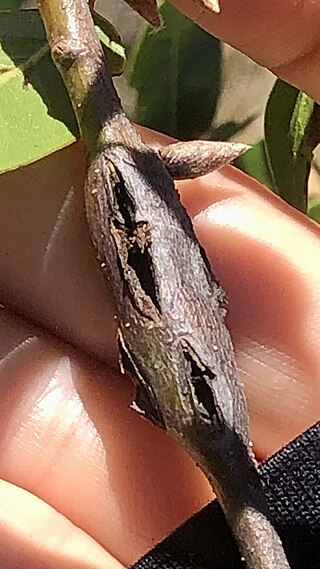
Callirhytis perdens, formerly Andricus perdens, the ruptured twig gall wasp, is a species of hymenopteran that induces integral stem galls on coast live oaks, interior live oaks, and canyon live oaks in California in North America. The wasps oviposit in the stem, and over time, the larval capsules are expelled from the lateral fissures onto the ground, where they either hatch in the leaf litter below the tree, or become fodder for grazing birds and other soil biota. This wasp is considered locally abundant.

Callirhytis eldoradensis, formerly Andricus eldoradensis, the acorn gall wasp, is a species of hymenopteran that induces galls on the acorns of coast live oaks, interior live oaks, and canyon live oaks in California in North America. This gall is not as readily visible as some of the showier oak galls, but exit holes may be visible on the acorns, and galled acorns are likely to stay on the tree after other acorns have dropped. The unisexual generation of this wasp produces a modest bud gall.
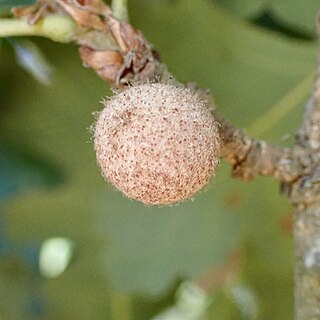
Burnettweldia washingtonensis, formerly Disholcaspis washingtonensis, the fuzzy gall wasp, is a species of hymenopteran that induces stem galls on white oaks on the Pacific coast of North America. The detachable galls have a little stem or neck, are gray or beige and fuzzy, and measure about 8–10 mm in diameter. The larval chamber is located at the center of the ball, the interior of which is otherwise chocolate brown. Older galls may appear pitted. The locally common galls induced by this wasp are sometimes mistaken for the galls induced by Besbicus conspicuus.
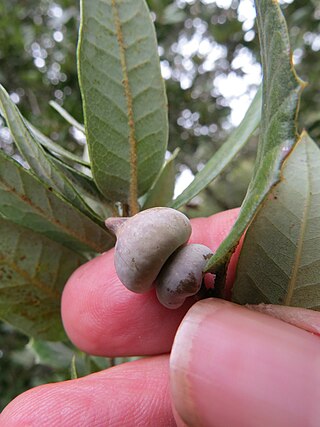
Heteroecus sanctaeclarae, also known as the mushroom gall wasp, is a species of cynipid wasp that induces galls on huckleberry oaks and canyon live oaks on the Pacific coast of North America.

Diplolepis bicolor, also known as the spiny bud gall wasp, is a species of cynipid wasp that induces bud galls on wild roses. This gall wasp is found throughout North America. The galls measure 10 to 12 mm in diameter and have a superficial resemblance to the leaf galls induced by Diplolepis polita.
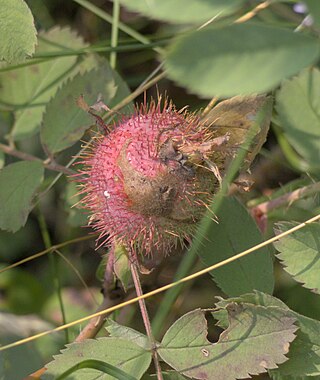
Diplolepis spinosa, also known as the many-spined twig gall wasp, is a species of cynipid wasp that induces galls on wild roses in North America. D. spinosa-induced galls are said to be "one of the most conspicuous" found in the grasslands of the continent.
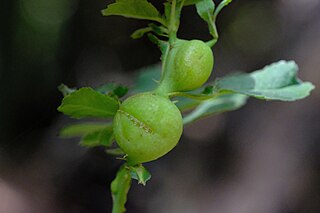
Diplolepis nodulosa, also known as the rose-stem gall wasp, is a species of cynipid wasp that induces bud galls on wild roses in North America. This galls induced by this species have a number of inquilines and parasitoids. D. nodulosa is assigned to a clade of Nearctic stem gallers within Diplolepis along with Diplolepis californica, Diplolepis oregonesis, Diplolepis spinosa, and Diplolepis triforma.

Diplolepis bassetti, also known as the mossy rose gall wasp, is a species of cynipid wasp that induces bud galls on wild roses in North America. Hosts include interior rose, Nootka rose, and pine rose.

















